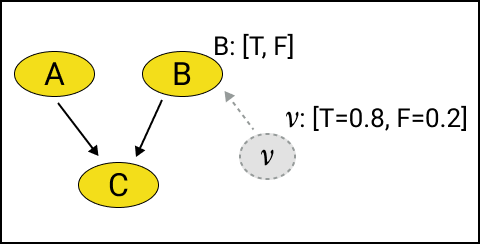Evidence uncertainty
Version: 1.0.0
Pattern language family: BN
Modeling phase:
3. The technical implementation
4. QA/QC
5. Communication of model findings
Modeling step:
7. Identification of model structure and parameters' values
9. Quantification of uncertainty
Problem:
How to handle cases when there is uncertainty associated with evidence or when evidence does not represent a direct observation? Setting an evidence for a node in the network will result in the belief of this node will be updated so it is $1$ for the state associated with the evidence and $0$ for all the other states, which implies certainty about the entered evidence. What happen in the cases when we are uncertain about evidence, e.g. if the evidence has a certainty of $80\%$, or if we wish to enter evidence as a probability distribution over the possible states for that node.
Solution:
In the cases where this problem occur, we use "virtual evidence" which means to adopt a new distribution over the node in question. This is achieved by creating a "virtual node" that carries the distribution of the evidence and passes it to the real node where we wish to add the uncertain evidence.
Structure: The solution proposed by this pattern have the following structure in a BN:
-
Assume that we wish to enter uncertain evidence for the node B as we are only $80\%$ sure that it is True.
-
We use virtual evidence by creating a virtual node $v$ whose CPT is the distribution over the states, i.e. [0.8 True, 0.2 False], and it passes the message with the new evidence distribution to B.

Fig.1 Assigning virtual evidence to the node B that incorporates the uncertainty about the evidence.
Constraints:
This solution works under the following conditions:
- The virtual evidence need to be a complete distribution, i.e. individual probabilities need to add up to $1$.
Related patterns:
Design choice and model quality:
- 1.R
- 4.R
Resources:
- Korb, K. B., & Nicholson, A. E. (2010). Bayesian artificial intelligence. CRC press.